
Ludowici is a city in Long County, Georgia, United States. The population was 1,703 at the 2010 Census and an estimated 2,221 in 2018. The city is the county seat of Long County. It is a part of the Hinesville-Fort Stewart metropolitan statistical area (MSA).

Tiles are usually thin, square or rectangular coverings manufactured from hard-wearing material such as ceramic, stone, metal, baked clay, or even glass. They are generally fixed in place in an array to cover roofs, floors, walls, edges, or other objects such as tabletops. Alternatively, tile can sometimes refer to similar units made from lightweight materials such as perlite, wood, and mineral wool, typically used for wall and ceiling applications. In another sense, a tile is a construction tile or similar object, such as rectangular counters used in playing games. The word is derived from the French word tuile, which is, in turn, from the Latin word tegula, meaning a roof tile composed of fired clay.
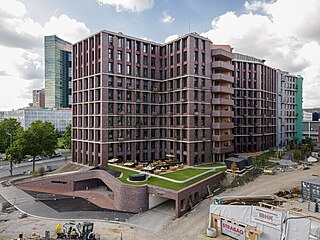
Wienerberger AG is an Austrian brick maker which is Europe's leading manufacturer of roof tiles and the world’s largest producer of bricks.

The imbrex and tegula were overlapping roof tiles used in ancient Greek and Roman architecture as a waterproof and durable roof covering. They were made predominantly of fired clay, but also sometimes of marble, bronze or gilt. In Rome, they replaced wooden shingles, and were used on almost every type of structure, from humble outbuildings to grand temples and public facilities.
Ludowici Roof Tile, LLC., based in New Lexington, Ohio, is an American manufacturer of clay roof tiles, floor tiles, and wall cladding. The company was established in 1888 with the formation of the Celadon Terra Cotta Company in Alfred, New York. It has created tile for many prominent buildings throughout the United States.

Architectural terracotta refers to a fired mixture of clay and water that can be used in a non-structural, semi-structural, or structural capacity on the exterior or interior of a building. Terracotta is an ancient building material that translates from Latin as "baked earth". Some architectural terracotta is stronger than stoneware. It can be unglazed, painted, slip glazed, or glazed.

The Claybank Brick Plant National Historic Site, located near Claybank, Saskatchewan at the foot of the Dirt Hills in the RM of Elmsthorpe No. 100, was an operational brick manufacturing plant from 1914 to 1989. Bricks manufactured at the site have been used to construct prominent Canadian buildings such as the Bessborough Hotel in Saskatoon and the Chateau Frontenac in Quebec City. The site was designated as a National Historic Site in 1996 and remains one of Canada's greatest examples of early twentieth century industrialism.

The Chicago Varnish Company Building is a building built in 1895 as the headquarters of one of the leading varnish manufacturers in the United States, the Chicago Varnish Company. The building is a rare example of Dutch Renaissance Revival-style architecture in Chicago, and is marked by a steeply pitched roof paired with stepped gables of red brick and light stone in contrasting colors. The building was designed by Henry Ives Cobb, a nationally recognized architect whose other significant works include the former Chicago Historical Society Building, the Newberry Library, and the original buildings for the University of Chicago campus. The building was listed on the National Register of Historic Places on June 14, 2001, and was designated a Chicago Landmark on July 25, 2001.

The Alliance Clay Product Company District is a historic district in Alliance, Ohio, United States. Listed on the National Register of Historic Places in 1978, it includes twelve contributing properties.

Dorchester Pottery Works is a historic site at 101-105 Victory Road in Dorchester, Massachusetts, a neighborhood of Boston. The Dorchester Pottery Works was founded in 1895 by George Henderson and made stoneware. The Dorchester Pottery Works closed in 1979. The building was designated as a Boston Landmark in 1980 and added to the National Register of Historic Places in 1985.

Mangalore tiles are a type of roof tile produced in the city of Mangalore, India. Tiles were first produced in the city by German missionaries of the Basel Mission of Switzerland, who also established weaving enterprises. Early Mangalore tiles followed the designs of the Gilardoni brothers of Altkirch, France, but over time the predominant pattern used was based on Wilhelm Ludowici's 1881 design for roof tile.
Brickworks is Australia's largest brick manufacturer, consisting of four divisions – Building Products Australia, Building Products North America, Industrial Property, and Investments.
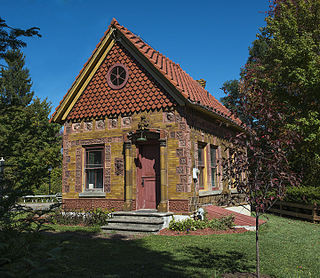
Terra Cotta Building is a historic office building and display center located at Alfred in Allegany County, New York. It was built in 1892 by the Celadon Terra Cotta Company. It is a one-story, 16-foot-wide (4.9 m), 25-foot-deep (7.6 m) building built almost entirely of bricks, ornamental terra cotta, and roofing tiles manufactured by Celadon. The building was designed as a sales office for the company, and was considered a "catalog" of their work. A replica was erected at the 1893 Columbian Exposition in Chicago. The building was the only remaining structure after a fire broke out on August 29, 1909 and destroyed the Alfred factory of the Ludowici-Celadon Company.

Roof tiles are overlapping tiles designed mainly to keep out precipitation such as rain or snow, and are traditionally made from locally available materials such as clay or slate. Later tiles have been made from materials such as concrete, glass, and plastic.
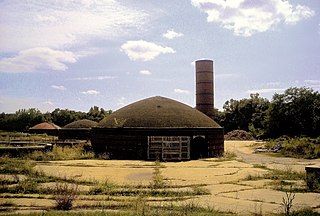
The United Brick Corporation Brick Complex, also known as the New York Avenue Brickworks, is a historic industrial site. It is located on the 2800 block of New York Avenue, NE in Washington, D.C. on the grounds of the United States National Arboretum. The site sits on federal land, and access by the public is restricted.

The Ascot Brick Works is a heritage listed former brick works located in Ascot, Western Australia. The brick works were constructed between 1929 and 1950 and used by Bristile until they ceased operations at the site in 1982.

The Former Tangrong Brick Kiln is a former brick manufacturing factory in Sanmin District, Kaohsiung, Taiwan.
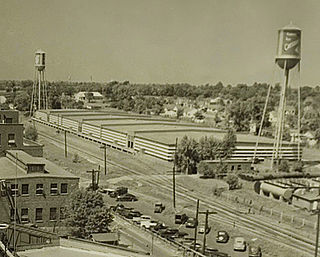
The Liggett and Myers Harpring Tobacco Storage Warehouse is a building located in Lexington, Kentucky. The building is significant for its association with the burley tobacco industry in Lexington, Kentucky between 1930 and 1980 and is currently listed on the National Register of Historic Places listings in Fayette County, Kentucky.

The Sanhe Tile Kiln is a former tile manufacturing factory in Dashu District, Kaohsiung, Taiwan.
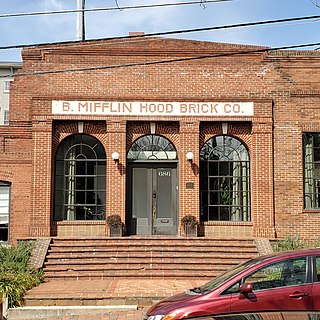
The B. Mifflin Hood Brick Company is a defunct American manufacturer of clay bricks and tiles that was based out of Atlanta, Georgia.























